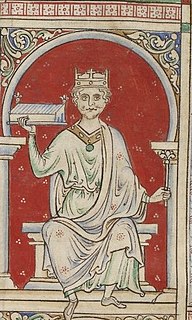John de Baalun or Balun (died 1235), was a justice itinerant and baron.
An eyre or iter was the name of a circuit traveled by an itinerant justice in medieval England, or the circuit court over which they presided, or the right of the monarch to visit and inspect the holdings of any vassal. The eyre involved visits and inspections at irregular intervals of the houses of vassals in the kingdom. The term is derived from Old French erre, from Latin iter ("journey"), and is cognate with errand and errant.
Baalun possessed estates in Gloucestershire, Herefordshire, and Wiltshire. He was descended in the male line from Roger de Breteuil, 2nd Earl of Hereford, but owed his surname and most of his lands to his descent from Hamelin de Baalun (d. 1104), who had been granted holdings in Wales and adjacent English counties by King William II. John's father, Reginald de Balun, had claimed some of these lands as maternal grandson of Hamelin, and in 1207 John de Balun paid a fine for the lands of Hamelin, on behalf of his father, to Geoffrey Fitz-Ace and Agnes, his wife, and 100 marks and a palfrey to the king. [1]
Roger de Breteuil, 2nd Earl of Hereford, succeeded in 1071 to the earldom of Hereford and the English estate of his father, William Fitz-Osbern. He is known to history for his role in the Revolt of the Earls

Hamelin de Ballon, (b ca. 1060, died 5 March 1105/6, was an early Norman Baron and the first Baron Abergavenny and Lord of Over Gwent and Abergavenny; he also served William Rufus.

William II, the third son of William the Conqueror, was King of England from 26 September 1087 until 2 August 1100, with powers over Normandy, and influence in Scotland. He was less successful in extending control into Wales. William is commonly known as William Rufus, perhaps because of his ruddy appearance or, more likely, due to having red hair as a child that grew out in later life.
In 12 John (1210–11) Balun accompanied the king to Ireland, but at the end of John's reign lost his lands for taking part in the barons' attack upon the king. On the accession of Henry III he was restored on returning to his allegiance, and in 9 Henry III (1224–5) was appointed a justice itinerant for Gloucestershire along with Matthew de Pateshull, archdeacon of Norfolk, Richard de Veym, and the abbot of Tewkesbury. He died in 1235. His son John paid 100l. for his relief, and did homage for his inheritance, and, dying in 1274, was succeeded by another of John's sons, Walter. John de Baalun was at the battle of Evesham 1265, having married Auda, sister and heir of William Paganell of Bohanton. [2]

Henry III, also known as Henry of Winchester, was King of England, Lord of Ireland, and Duke of Aquitaine from 1216 until his death. The son of King John and Isabella of Angoulême, Henry assumed the throne when he was only nine in the middle of the First Barons' War. Cardinal Guala declared the war against the rebel barons to be a religious crusade and Henry's forces, led by William Marshal, defeated the rebels at the battles of Lincoln and Sandwich in 1217. Henry promised to abide by the Great Charter of 1225, which limited royal power and protected the rights of the major barons. His early rule was dominated first by Hubert de Burgh and then Peter des Roches, who re-established royal authority after the war. In 1230, the King attempted to reconquer the provinces of France that had once belonged to his father, but the invasion was a debacle. A revolt led by William Marshal's son, Richard, broke out in 1232, ending in a peace settlement negotiated by the Church.
The Archdeacon of Norfolk is a senior ecclesiastical officer in the Church of England Diocese of Norwich, who exercises supervision of clergy and responsibility for church buildings within the geographical area of her or his archdeaconry.







